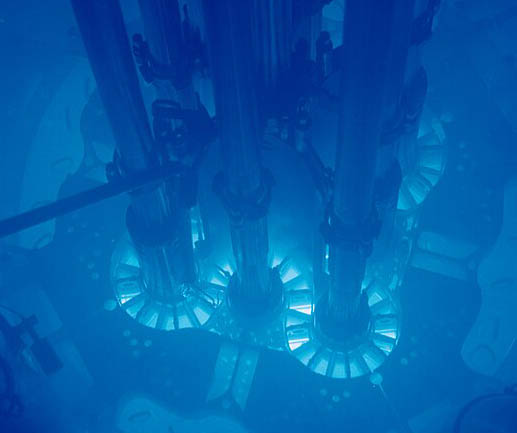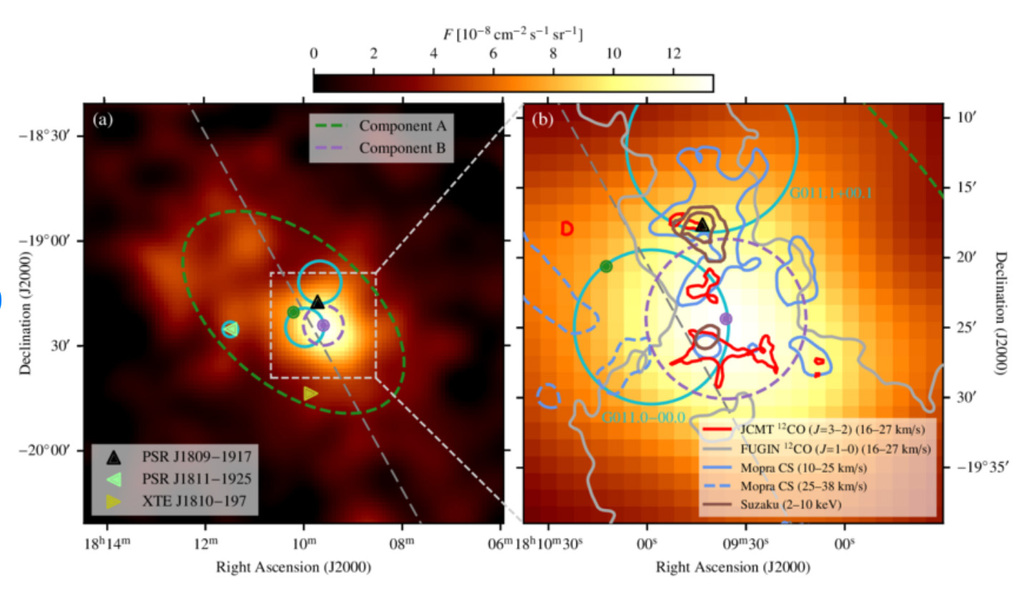I’m sitting in Cape Town waiting for my flight to depart and thought I’d write one last piece from the International Astronomical Union meeting I’ve attended for the last week. In a few hours I’ll board an A350 wide-body airplane, to be spit out in Atlanta 15 hours later, and back home a few hours after that. It’s been a wonderful visit – in addition to the astronomy, I’ve met some great people, had scintillating and thought-provoking conversations, learned quite a bit, and even got to see some of the wildlife (penguins, ostriches, eland, baboons, and the mighty four-striped grass mouse. But, as fascinating as the grass mouse can be, what I really want to talk about is Cherenkov radiation – and once you know where it comes from, I suspect you’ll be intrigued by the amount of information we can glean from it. So what ‘cha say we get started?
Have you ever seen the blue glow from a nuclear reactor core – maybe in a photo or TV show?

That’s Cherenkov radiation! I’ve seen it emanating from the core of a small research reactor, from a very high-activity radioactive source, and from the spent fuel pool at a Chernobyl-type reactor. What causes it is charged particles – electrons or protons for example – that are traveling faster than the speed of light. And before reminding me that nothing can travel faster than the speed of light, let me explain!
Einstein’s speed limit is still the law of the universe (Star Trek notwithstanding) – but there’s an important part that’s often left out – nothing that we know of can travel faster than the speed of light in a vacuum. But the water that cools a reactor core, that shields radiation from a high-activity source, or that circulates past casks storing spent reactor fuel is not a vacuum, and light travels more slowly through water than it does through vacuum. This means that an electron (for example) that’s zipping through the water at less than the speed of light in a vacuum can still be traveling faster than the speed of light in water. Similarly, the speed of light in air at normal atmospheric pressure (760 mm Hg) at 20 C and 50% humidity is 299,711,143 meters per second, the barest whisker slower than its speed in vacuum (299,792,458 meters per second). This means that a proton or electron moving through the atmosphere at any speed between 299,792, 458 m/s and 299,711,143 m/s is going to leave behind a thin wake of bluish-purple photons…and if we’re using the right sort of telescope, we can see those photons and, from them, we can infer the presence of a particle just as we can see a wake in water and infer the presence of a speedboat.
What HESS does is very cool – it uses multiple telescopes to search the skies over the Namibian desert, looking for a burst of bluish-purple photons. Seeing them, the multiple telescopes will each be pointed in a slightly different direction – the point at which their lines of sight intersect is the location of the particle that slammed into our atmosphere; not only that, but by tracing the particle’s path backwards the telescope can help astronomers figure out where it originated.

Interestingly, the incoming particles don’t just enter the atmosphere, slam into an atom, emit a flash of photons, and vanish – slamming into an atom is only the first step of a fairly complex process. See, incoming particles with such energy don’t just strike an atom – they have the ability to shatter it and the pieces of a shattered atom are also charged particles; as they filter down through the atmosphere they also emit Cherenkov radiation, as do the tertiary particles that are formed when these secondary particles pass through the atmosphere. This process continues until all of the particles are slowed down to the point where they are traveling slower than the speed of light in air – by measuring this process astronomers can know how much total energy was dumped into our atmosphere. That, in turn, tells them not only where the particle originated, but how much energy it was carrying – a number that can be staggeringly large. In fact, the highest energy particles consist of a single atom that has as much kinetic energy as a quickly-moving pebble. It boggles the mind to think of a single atom packing as much energy as something I can pick up and hold in my hand.
In addition to detecting particles, HESS can also see cosmic ray air showers initiated by photons – the incident object isn’t as important as the fact that anything of that energy that interacts with an atom in the atmosphere is likely to create charged particles, and it’s those charged particles that can generate the Cherenkov radiation. And since photons aren’t affected by magnetic fields, we can trace them back to their point of origin, often correlating them with a particular galaxy or cosmic event or location in the sky.
To me, this whole process is just very cool. First, there’s the mystery of how the very highest-energy photons and particles get their energy – we’re starting to narrow down the possibilities (some, for example, seem to pick up energy from the shock waves from exploding stars – supernovae), but there are likely other processes out there that we need to learn about. Second is that these particles, which are electrically charged, speed from where they were produced to us here on Earth, traveling through space that’s laced with the galactic magnetic field, which can deflect the particles slightly, making it a little tricky sometimes to figure out where they originated. And third, the process of producing Cherenkov radiation is what makes this whole endeavor possible – not only does it hinge on these particles traveling almost impossibly quickly through the cosmos, but also on an improbable-seeming process in physics that makes them visible to us at the surface. And finally, that the same process I’ve seen with my own eyes in pools of water containing nuclear reactor cores, dangerously radioactive sources, and spent reactor fuel is also taking place in the air above my head – how cool is that?
References:
- HESS has graciously allowed us to post the data and images included in this article.
